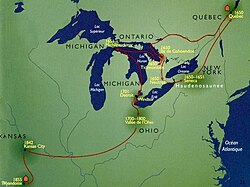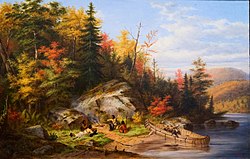Wyandot people
The Wyandot people (also called Wendats or Huron) are a tribe of Native Americans. Samuel de Champlain traded fur with them. In the 17th and 18th centuries they were allies of New France, and enemies of the Iroquois and New Netherland and New York.
| Total population | |
|---|---|
| 5800[1] (2001) | |
| Regions with significant populations | |
| Canada – Quebec, southwest Ontario United States – Ohio, Oklahoma, Michigan, Kansas | |
| Languages | |
| French, English, revival of Wendat | |
| Religion | |
| Animism, Roman Catholicism, Other | |
| Related ethnic groups | |
| Petun, other Iroquoian peoples |
The Wyandots signed the Treaty of Detroit on November 17 in the year 1807. They signed it with other Native Americans from three other tribes called the Odawa, Ojibwe and Potawatomi. The tribes gave up areas of Michigan and Ohio to the United States to own.[2]
Wyandot People Media
Le Grand Voyage du Pays des Hurons, Gabriel Sagard, 1632
Main body of Georgian Bay highlighted on the map of the Great Lakes directly above Lake Ontario, with its outlet on the Saint Lawrence River. This is where the Huron encountered the French.
Three Huron-Wyandot chiefs from the Huron reservation (Lourette) now called Wendake in Quebec, Canada. After their defeat by the Iroquois, many Huron fled to Quebec for refuge with their French allies, where a reserve was set aside for their use. Others migrated across Lake Huron and the St. Clair River, settling in the northern Ohio and Michigan region.
William Walker (1800–1874), a leader of the Wyandot people and a prominent citizen of early-day Kansas.
Huron Hunters Camping at the Big Rock of Lake Lagon, by Cornelius Krieghoff, 1862
References
- ↑ Lloyd Divine, Culture Committee Chairman. "A Brief Profile". Wyandotte-Nation.org. Archived from the original on July 1, 2020. Retrieved July 21, 2020.
- ↑ "Treaty Between the Ottawa, Chippewa, Wyandot, and Potawatomi Indians". World Digital Library. 1807-11-17. Retrieved 2013-08-03.








